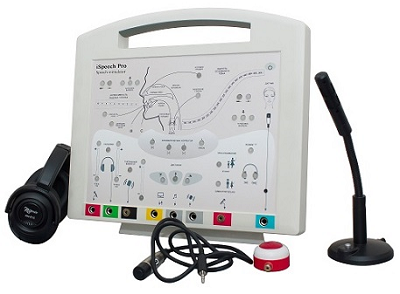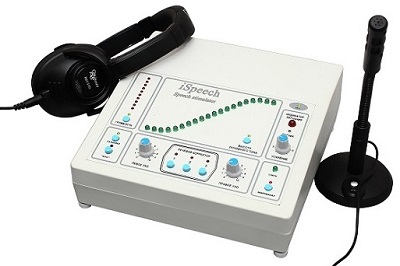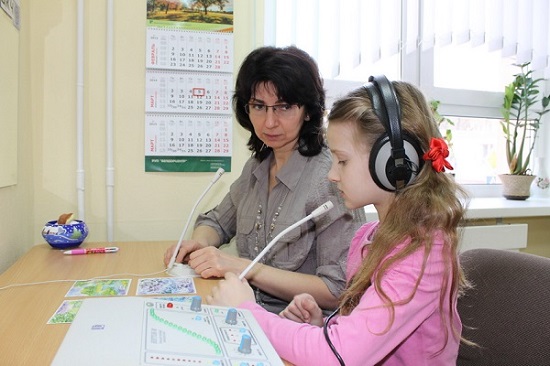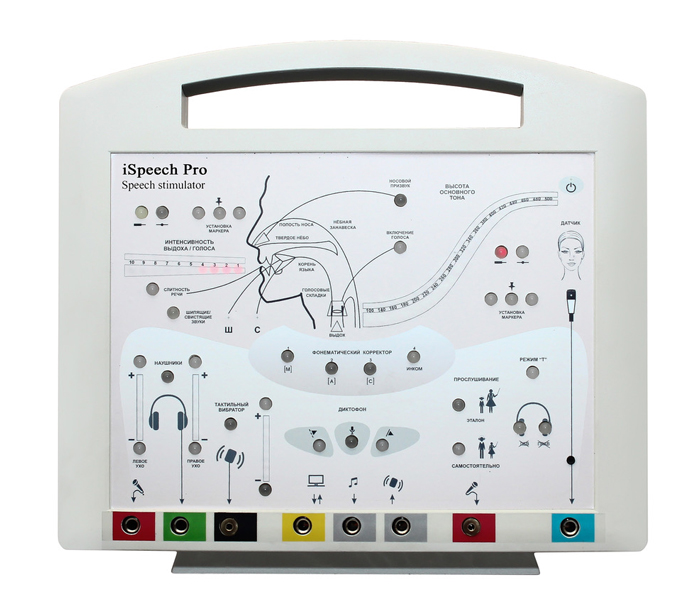
 iSpeech - multisensory speech stimulator
iSpeech - multisensory speech stimulator
Please ask your questions in ONLINE-CHAT at the bottom right corner of the screen or by feedback form here:
There are two versions of the device:
- iSPEECH
- iSPEECH PRO
iSpeech – speech stimulator
iSpeech is a speech stimulator for development of speech hearing, for visual control of work of nose resonator of a person, for control of inclusion/deactivation of the voice ligaments, for pitch control, for control of level of speech signal intensity with vibration-tactile support.
DESIGNATION AND COMPOSITION OF ISPEECH

Multi-sensory speech stimulator "iSpeech" is designed for individual speech work. The device provides simultaneous control of phonetic elements of speech on the visual, auditory (residual hearing) and vibration-tactile channels of perception.
"iSpeech" allows you to visually control the change in pitch (frequency of vibration of the vocal cords), differentiate voiceless and voiced consonants, differentiate nasal and oral sounds, to work on loudness, rhythm and fusion of spoken words and phrases. In addition, the device can detect open forms of rhinolalia and rhinophony (so-called "nasal") and correct this defect in speech.
In addition to visual control of phonetic elements of speech, iSpeech provides auditory control of speech exercises. For these purposes, the device includes power amplifier, speech spectral corrector, headphones, and behind-the-ear inductor (BTE), which makes it possible to work with a hearing aid.
Work of the auditory and visual channels of speech perception is supplemented by vibration-tactile sensitivity due to the connection of a tactile vibrator to the device.
Functional organization of "iSpeech" stimulator allows to vary methods of training: to conduct training exercises for arbitrary control of the phonetic organs, to formulate with the help of the teacher normative pronunciation skills, to consolidate the acquired skills through repetitions and self-control.
The stimulator can work in combination with a personal computer and other modern sources of voice information.
The basic structure of the stimulator includes:
- the electronic unit of the simulator
- two microphones (for pupil and teacher)
- sound indication sensor
- behind-the-ear inductor (BTE)
- Headphones
- device for the formation of vibration-tactile sensations (tactile vibrator)

FUNCTIONAL STRUCTURE OF THE SIMULATOR
For visual control of speech parameters, a light indication is provided in the device. There is a ten-element luminous intensity scale. With a weak sound of the voice coming into the microphone, two or three light elements on the scale light up, at a strong one - up to ten. To indicate the pitch of the main tone (frequency of vibration of the vocal cords) a twenty-element light scale is provided. With increasing pitch, the number of luminous elements of the scale increases.
In addition to luminous scales of sound intensity and frequency of the main tone, the instrument has a light indicator for recording the nasal sound in the speech, which lights up when there is a sound. This indicator allows you to differentiate the nasal and oral sounds (in the norm), and also to reveal in the speech an open form of rhinolalia and rhinophony. When working in this mode, the INZ sensor is used, which is pressed against the nose wing (usually to the soft bottom of the nose). To select the required sensitivity of the sensor, there is a regulator to ensure that the LED indicator reliably lights up in the presence of a nasal sound, but at the same time it should not have a constant illumination (due to excessive sensitivity): the maximum sensitivity corresponds to the extreme right position of the regulator (clockwise).
In addition, the indicator of nasal/mouth sounds can be used to differentiate voiced and voiceless consonants in speech. In this case, the sensor is pressed against the neck in the region of the larynx (a pit over the clavicles or just above). The indicator lights up when pronouncing voiced consonants (and vowels), but does not light up when voiceless consonants are spoken.
On the front panel of the device there is a light indicator "CONC.", through which concatenation of utterance of words and phrases is controlled: the LED lights up during the pronunciation and goes out in pauses. This indicator can also be used to observe the rhythm of speech.
Visual control of speech can be supported by simultaneous listening to speech exercises. To do this, you need to use a microphone and headphones connected to the device, or a behind-the-back inductor, which transmits the speech signal to the hearing aid. The device has a separate volume control for the left and right ear.
The amplitude-frequency correction used in the device has three independent channels, in each of which the speech signal is amplified in a certain frequency range.
If all channels are disabled, then the speech signal is amplified evenly over the entire speech frequency range.
The first channel amplifies the frequency range of the fundamental tone (i.e., the frequency range of the vibration of the vocal cords). The spectral components of this region bear the basic information about the intonational-rhythmic characteristics of speech.
The second channel amplifies the sound in the frequency range of the first formants of vowels and sonorous sounds.
The third channel improves the perception and differentiation of hissing and whistling sounds.
Such speech correction is created taking into account the spectral structure of speech sounds. It amplifies phonetically informative spectral areas, thereby increasing the intelligibility of perceived speech.
Additional control over the performance of speech exercises can be carried out using a tactile vibrator.
The device provides the possibility of hearing protection in persons who has the phenomenon of accelerated increase of sound volume. "FUNG" is the mode of limiting the dynamic range of sound amplification.
NOISE SYSTEM FOR IMPROVEMENT OF HEARING PERCEPTION OF SPEECH
The iSpeech stimulator uses a special technology for isolating speech from ambient noise - a noise reduction system that can be turned on by the "NOISE" switch located on the rear panel of the device.
When the noise reduction is turned on, only the speech signal of the teacher and your voice will be input to the headphones or to the hearing aid of the student, and the signals and noises of the surrounding background will be suppressed.
If the noise reduction is turned on, the microphone should be placed close enough to the mouth and you should speak clearly and loudly.
iSpeech Pro – multisensory speech stimulator, 2nd generation
A new modification of iSpeech multisensory speech stimulator was created in 2017. In its development, many years of successful experience in using iSpeech model in the tasks of forming and correcting oral speech are taken into account, and also the wishes of specialists actively working with the device are taken into account.
iSpeech Pro stimulator, which includes all the basic functions of the previous model, has the following significant changes, expanding its capabilities:
- In the design, a vertical front panel is realized, which greatly improves the perception of students by visual means of display. As a result, it became possible to use the device for collective training.
- Along the light scales "Intensity of exhalation/voice" and "Height of the main tone" are realized moving markers that allow the specialist (teacher) to specify certain control points on the scale. If the "exhalation/voice intensity" scale is used, the teacher will use the marker reference points to give a task to the student in the process of working the exhalation force or the volume of the voice. In case of use of the scale "height of the main tone" movement of the light marker allows the teacher to set the student such tasks as: to what point should he bring the height of the voice, from what level to raise the height, to what target point to hit the voice and others.
- A special light indication on the instrument panel makes it possible to work on differentiating the sounds "S" and "SH". In addition, this form of work can be considered as a general training of the articulation organs, since these sounds differ significantly both in the position of the tongue and in the state of the lips.
In addition, the device provides other additional functions and modes of operation, for example, the simulator has a digital voice recorder that allows you to record and reproduce the speech of the teacher or student.
For any questions you can contact us by live-chat in the lower right corner of the screen
Mail: This email address is being protected from spambots. You need JavaScript enabled to view it.
Skype: tenmed1
Phone: +7-495-642-55-73



